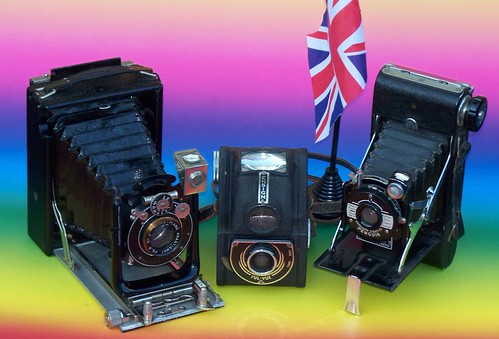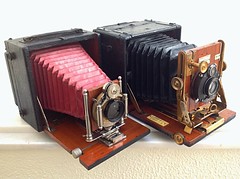Great Britain
| British companies | ||
| Adams & Co. | Agilux | Aldis | APeM | Aptus | Artima | Barnet Ensign | Beard | Beck | Benetfink | Billcliff | Boots | British Ferrotype | Butcher | Chapman | Cooke | Corfield | Coronet | Dallmeyer | Dekko | De Vere | Dixons | Dollond | Elliott | Gandolfi | Gnome | Griffiths | G. Hare | Houghtons | Houghton-Butcher | Hunter | Ilford | Jackson | Johnson | Kentmere | Kershaw-Soho | Kodak Ltd. | Lancaster | Lejeune and Perken | Lizars | London & Paris Optic & Clock Company | Marion | Marlow | Meagher | MPP | Neville | Newman & Guardia | Pearson and Denham | Perken, Son and Company | Perken, Son & Rayment | Photopia | Purma | Reid & Sigrist | Reynolds and Branson | Ross | Ross Ensign | Sanderson | Sands & Hunter | Shackman | Shew | Soho | Standard Cameras Ltd | Taylor-Hobson | Thornton-Pickard | Underwood | United | Watkins | Watson | Wynne's Infallible | Wray |

|
| Cameras of the United Kingdom united under the Union Jack image by Uwe Kulick (Image rights) |

|
| Fine stuff from the Great Era of British Cameras around 1900 image by Luis Cozeto (Image rights) |
Many basics of photography were invented in France, but two main principles of so-called analogue photography were found at once by a gentleman from Wiltshire, England, Great Britain. William Henry Fox Talbot invented the first photographical negative/positive process, and for this process also the photo paper. If anything stayed in photography business since its very beginning it is the use of specially prepared paper for the prints. In Talbot's process it was the same kind of silver chloride paper that he used for the negatives. Nowadays a special coated glossy paper is needed that allows printing images with inkjet-printers. The only other basic element that stayed in photography is the usage of a camera for making the exposures onto some light-sensitive plane. Of course most cameras use lenses to improve the imaging results. Big steps forward in that area was made by Londoner John Dollond, patenting the first achromatic lens, and Harold Dennis Taylor from West-Yorkshire who invented the colour-corrected triplet lens.
Popular photography is not an invention of the Americans, no, it was Frederick Scott Archer, a guy from Hertfordshire who invented the first quite popular photographic process and gave it to the world for free, the Collodion Photographic Process which allowed one to make quite sharp negatives on glass plates instead of the less sharp negatives on paper. And professional photography was enriched significantly by the inventiveness of F. H. Sanderson, another 19th century Briton who invented the flexible modern type of view camera. And what would those modern cameras have been without modern shutters? Arthur Samuel Newman invented the leaf shutter.
Links
- The Royal Photographic Society
- National Photography Collections at the National Media Museum, Bradford, UK.
- Photography hub page at the Victoria and Albert Museum, London.
- British Photographic Companies at Grace's Guide to British companies